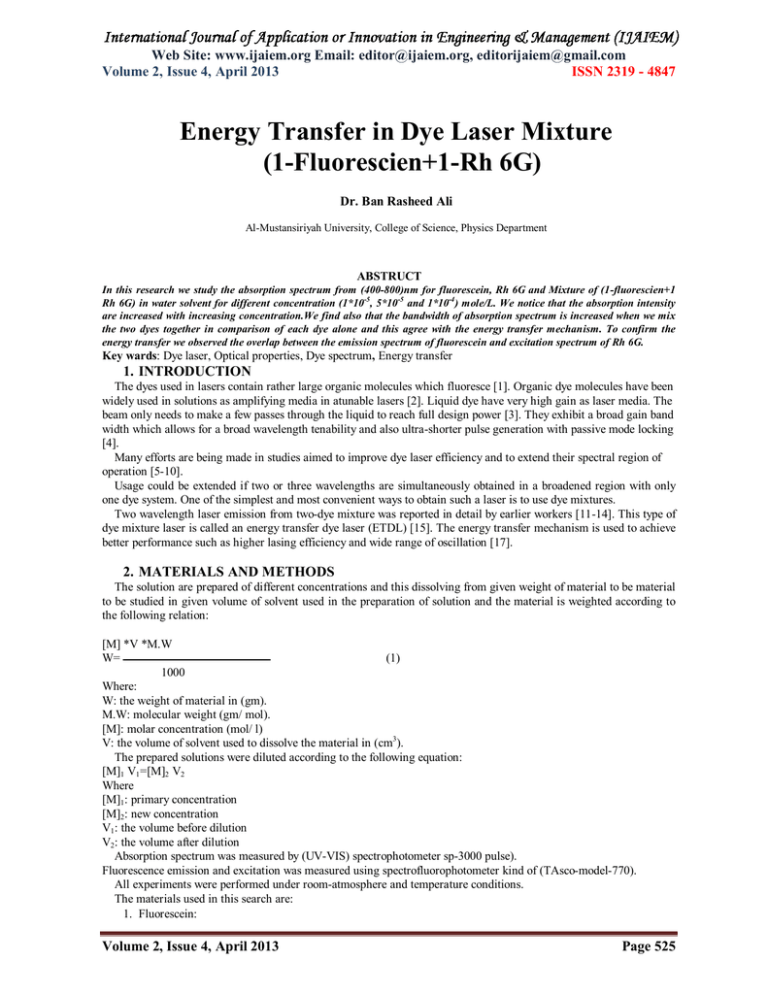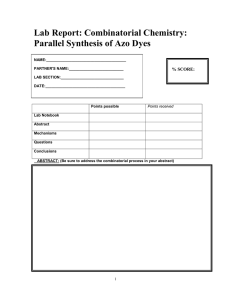Web Site: www.ijaiem.org Email: , Volume 2, Issue 4, April 2013
advertisement

Web Site: www.ijaiem.org Email: editor@ijaiem.org, editorijaiem@gmail.com Volume 2, Issue 4, April 2013 ISSN 2319 - 4847 Energy Transfer in Dye Laser Mixture (1-Fluorescien+1-Rh 6G) Dr. Ban Rasheed Ali Al-Mustansiriyah University, College of Science, Physics Department ABSTRUCT In this research we study the absorption spectrum from (400-800)nm for fluorescein, Rh 6G and Mixture of (1-fluorescien+1 Rh 6G) in water solvent for different concentration (1*10-5, 5*10-5 and 1*10-4) mole/L. We notice that the absorption intensity are increased with increasing concentration.We find also that the bandwidth of absorption spectrum is increased when we mix the two dyes together in comparison of each dye alone and this agree with the energy transfer mechanism. To confirm the energy transfer we observed the overlap between the emission spectrum of fluorescein and excitation spectrum of Rh 6G. Key wards: Dye laser, Optical properties, Dye spectrum, Energy transfer 1. INTRODUCTION The dyes used in lasers contain rather large organic molecules which fluoresce [1]. Organic dye molecules have been widely used in solutions as amplifying media in atunable lasers [2]. Liquid dye have very high gain as laser media. The beam only needs to make a few passes through the liquid to reach full design power [3]. They exhibit a broad gain band width which allows for a broad wavelength tenability and also ultra-shorter pulse generation with passive mode locking [4]. Many efforts are being made in studies aimed to improve dye laser efficiency and to extend their spectral region of operation [5-10]. Usage could be extended if two or three wavelengths are simultaneously obtained in a broadened region with only one dye system. One of the simplest and most convenient ways to obtain such a laser is to use dye mixtures. Two wavelength laser emission from two-dye mixture was reported in detail by earlier workers [11-14]. This type of dye mixture laser is called an energy transfer dye laser (ETDL) [15]. The energy transfer mechanism is used to achieve better performance such as higher lasing efficiency and wide range of oscillation [17]. 2. MATERIALS AND METHODS The solution are prepared of different concentrations and this dissolving from given weight of material to be material to be studied in given volume of solvent used in the preparation of solution and the material is weighted according to the following relation: [M] *V *M.W W= (1) 1000 Where: W: the weight of material in (gm). M.W: molecular weight (gm/ mol). [M]: molar concentration (mol/ l) V: the volume of solvent used to dissolve the material in (cm3). The prepared solutions were diluted according to the following equation: [M]1 V1 =[M]2 V2 Where [M]1: primary concentration [M]2: new concentration V1: the volume before dilution V2: the volume after dilution Absorption spectrum was measured by (UV-VIS) spectrophotometer sp-3000 pulse). Fluorescence emission and excitation was measured using spectrofluorophotometer kind of (TAsco-model-770). All experiments were performed under room-atmosphere and temperature conditions. The materials used in this search are: 1. Fluorescein: Volume 2, Issue 4, April 2013 Page 525 Web Site: www.ijaiem.org Email: editor@ijaiem.org, editorijaiem@gmail.com Volume 2, Issue 4, April 2013 ISSN 2319 - 4847 Fluorescein is a synthetic organic compound available as a dark orange/ red powder belong to Xanthene family,soluble in water and alcohol. Molecular formula (C20H12 O5), molar mass (332.31 g/ mol), solubility in water is slightly, and the structural formula is [5]: 2. Rh 6G: Rh 6G is a synthetic organic compound available as a dark reddish purple, brown or black crystalline solid. Belong to xanthene family. The molecular formula (C28H31N2O3Cl), molar mass (479.02 g/mol), solubility in water 20 g/ l at (25 ºC) and the structural formula is [6]: 3. Water H2 O: It is polar solvent used in the melt of dye molecules. The molecular mass is (18.015 gm/ mol) and the dielectric constant is (80.01) and it has melting point (0.00 ºC), boiling point (100 ºC), refractive index (1.33) and the structural formula is: 3. RESULTS AND DISCUSSION Fig 1, 2, 3 UV-VIS absorption spectra fordifferent concentration (1*10-5, 5*10-5 and 1*10-4) mole/L with wavelength range (400-800)nm. Fig (1) UV-VIS absorption spectrum for Rh 6G at different concentration Fig (2) UV-VIS absorption spectrum for Fluor. at different concentration Volume 2, Issue 4, April 2013 Page 526 Web Site: www.ijaiem.org Email: editor@ijaiem.org, editorijaiem@gmail.com Volume 2, Issue 4, April 2013 ISSN 2319 - 4847 Fig (3) UV-VIS absorption spectrum for Mixture of (1-Fluor.+1-Rh 6G) at different concentration Initially it has been observed that the absorption intensity at maximum wavelength is increased with increasing concentration for all types of dye laser (Fluorescein, Rh 6G and mixture of Fluor.+Rh 6G) and this satisfy agreement with reported research [16-17]. Also we notice from these figures that the bandwidth of the absorption spectra are increased for each concentration for the mixture of (flour.+Rh 6G) dye in comparison of fluorescein dye and Rh 6G dye alone because of the energy transfer mechanism which is used in this research by mixing two dyes together. To confirm the energy transfer process, the excitation spectrum of Rh 6G is plotted with emission spectrum of flour. Fig (4, 5). The extent of energy transfer depends on the area of overlap. Since the area under the emission spectrum of flour. Overlaps with the excitation spectrum of Rh 6G, energy transfer from flour. to Rh 6G in the dye mixture is possible [18]. Fig(4): show absorption spectra at concentration (5*10-5) Fig(5): show absorption spectra at concentration (1*10-4) Fig(6): show absorption spectra at concentration (1*10-4) Volume 2, Issue 4, April 2013 Page 527 Web Site: www.ijaiem.org Email: editor@ijaiem.org, editorijaiem@gmail.com Volume 2, Issue 4, April 2013 ISSN 2319 - 4847 It is observed from fig (5, 6) that the peak emission of flour. shows a red shift as a concentration is increased. This may be attributed to the dimer formation and increased in ground state absorption. Our interest in dye mixture laser because of the following advantages. (i) It is wide range of tunability from UV to IR. (ii) The simplicity of its requirement of only one dye cell and one solution so that the alignment is not disturbed. (iii)An abundance of the kind of the laser dye that can be made to cover awide spectral range. Con. Mol/L 1*10-5 5*10-5 1*10-4 Con. Mol/L 1*10-5 5*10-5 1*10-4 Con. Mol/L 1*10-5 5*10-5 1*10-4 Dye Rh 6G Fluor. Rh 6G Fluor. 478 479 480 Table(1) Fluorescein Intensity a.u. 0.188 0.354 2.944 64 65 70 521 526 526 Table( 2) Rh 6G Intensity a.u. 0.287 0.561 3.118 35 35 63 Table(3 ) Mixture (1-Fluor.+1-Rh 6G) Intensity a.u. 526 0.12 526 0.182 526 0.93 Table(4 ) Spectrum information Typeofspectrum ConcentrationMole/L Excitation 1×10^-5 Emission 1×10^-5 Excitation 1×10^-4 Emission 1×10^-4 99 100 100 537 513 553 522 REFERENCES [1] Yaqoob M. Jawad, “Study the effect of concentration and solvent polarity on 1-Naphthylamine quantum efficiency”, master thesis, ch1, college of science, Al-MustansiryiaUniversity(2011),. [2] J. Garcia Sole, L. E. Bausa and D. Jaque, “An Introduction to the optical spectroscopy of inorganic solids”, John Wiley and sons, Madrid, (2005). [3] F. P. Schafer ,“Topics in applied physics”, vol. 1. Dye lasers springer, Berlin, (1990). [4] William T., “Laser fundamentals”, p. 397-399, Cambridge University press, (1996). [5] D. R. L.ide,“CRC hand book of chemistry and physics”, Copyright Taylor and Francis group LLC, (2006). [6] Haithem M. Mikhlif,"The Effect of Oxygen on Absorption and Emission spectra for some Organic laser Dyes", master thesis ,ch2,college of science , Al-Mustansyriah University, (2001). [7] B. B. Raja, T. G. Varadarajan, laser chemistry, 16 -109 , (1995). [8] M. A. El Kemary,Canadian J. Analytical sciences and spectroscopy 43-95, (1998). [9] H. K. Law et al., Applied optics, 37-5694, (1988). [10] O. J. Rolinski et al., chem.. phys. Letters 309-395, (1995). [11] S. Muto et al., Electronics and communications in Japan 67-104,(1999). [12] L. Taneje et al. , Optcs communications III 463, (1994). [13] T. Govindamunny and B. M. Sirarm , J. Lumen 21-397, (1980). [14] S. Muto et al., J. Appl. Phys. 21 -532, (1982). [15] M. I. Saradatti et al., J. chem. Soc. Faraday Trans 82-2417, (1986). [16] H. F. Sa’adallah,“Spectroscopic properties study of polymer film doped by dye laser organic Type (C102) ”, Master thesis/ college of science/ Al-Mustansiriyah University, (2007). [17] H.K. Saeso, "Spectral study of polymeric R110 Thin films", Master thesis, Ch.4, Al-Mustansiriyah University, College of Science , (2010). Volume 2, Issue 4, April 2013 Page 528 Web Site: www.ijaiem.org Email: editor@ijaiem.org, editorijaiem@gmail.com Volume 2, Issue 4, April 2013 ISSN 2319 - 4847 [18] S. A. Ahmed et al., J. of chem.. phys. 61-1584 , (1974) Author Dr Ban Rasheed Ali.ReceivedB.Sc. Degree from Al-MustansyriahUniversity-(1989). Received M.Sc. degree from Baghdad University (1995) in molecular physics. Received Ph. Degree from AlMustansyriah University (2003) in Laser. Volume 2, Issue 4, April 2013 Page 529



